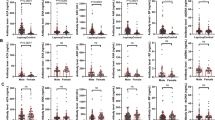Summary
In the sera of patients with lepromatous leprosy anti-DNP antibodies were detected in order to determine the mode of ployclonal B-cell activation. Anti-DNP antibodies were found in 30% of the patients with active lepromatous leprosy and in 8% of those with inactive lepromatous leprosy. The level of anti-DNP antibodies in active patients was significantly higher than the level in inactive patients and control. However, the presence of anti-DNP antibodies was unrelated to the production of circulating immune complexes and antinuclear antibodies. These results suggest that polyclonal B-cell activation might occur but that the B-cell clones stimulated by M. leprae are different from patient to patient.
Similar content being viewed by others
References
Masala C, Amendolea MA, Nuti M, Riccarducci R, Tarabini CGL, Tarabini CG (1979) Autoantibodies in leprosy. Int J Lepr 47:171–175
Moran C, Ryder G, Turk JL, Water MFR (1972) Evidence for circulating immune complexes in lepromatous leprosy. Lancet 2:572–573
Gupta SC, Chhabra B, Mehrotra TN, Bajaj AK (1982) A study of antispermatozoal antibodies in leprosy. Int J Lepr 50:43–46
Nath I, Curtis J, Bhutani LK, Talwar GP (1974) Reduction of a subpopulation of T-lymphocytes in lepromatous leprosy. Clin Exp Immunol 18:81–87
Nath I, Curtis J, Sharma AK, Talwar GP (1977) Curculating T-cell numbers and their mitogenic potential in leprosy-correlation with mycobacterial load. Clin Exp Immunol 29:393–400
Bullock WE, Watson S, Nelson KE, Schauf V, Makonkawkeyoon S, Jacobson RR (1982) Aberrant immunoregulatory control of B-lymphocytes function in lepromatous leprosy. Clin Exp Immunol 49:105–114
Furukawa F, Ozaki M, Imamura S, Yoshida H, Pinrat A, Hamashima Y (1982) Associations of circulating immune complexes, clinical activity and bacterial index in Japanese patients with leprosy. Arch Dermatol Res 274:185–188
Furukawa F, Sekita K, Hamashima Y, Ozaki M, Imamura S (1983) Evaluation of circulating immune complexes and antinuclear antibodies in Japanese patients with leprosy. Arch Dermatol Res 275:144–146
Ridley DS, Joplin WH (1966) Classification of leprosy according to immunity. A five-group system. Int J Lepr 34:255–273
Japanese Leprosy Committee (1959) Clinical classification of leprosy (in Japanese) Lepra 28:391–392
Hirose S, Maruyama N, Ohta K, Shirai T (1980) Polyclonal B-cell activation and autoimmunity in New Zealand mice 1: natural thymocytoxic autoantibodies (NTA). J Immunol 125:610–615
Eisen HN, Carsten ME, Belman S (1954) Studies of hypersensitivity to low molecular weight substances: III—the 2,4-dinitrophenyl group as a determinant in the precipitin reaction. J Immunol 73:296–308
Hay FC, Nineham LJ, Roitt IM (1976) Routine assay for the detection of immune complexes of known immunoglobulin class using solid phase Clq. Clin Exp Immunol 24:396–400
Yonemasu K, Stroud RM (1971) Clq rapid purification method for preparation of monospecific antisera and for biochemical studies. J Immunol 106:304–313
Koike T, Nagasawa R, Nagata N, Shirai T (1982) Specificity of mouse hybridoma antibodies to DNA. Immunol Lett 4:93–97
Izui S, McConahey PJ, Dixon FJ (1978) Increased spontaneous polyclonal activation of B-lymphocytes in mice with spontaneous autoimmune disease. J Immunol 121:2213–2219
Hirose S, Yoshida H, Ohta K, Nakai Y, Maruyama N, Shirai T (1981) Polyclonal B cell activation and autoimmunity in New Zealand mice: Anti DNA antibodies and proteinuria. In: Shiokaw, Abe and Yamauchi (eds) New horizons in rheumatoid arthritis. Elsevier, North Holland, p 102
Shirai T, Hirose S, Yoshida H, Fururkawa F, Sano H, Hamashima Y, Yumura K (1982) Polyclonal B-cell activation and anti-DNA antibodies in systemic lupus erythematosus. In: Hayashi (ed) Annual report of Ministry of Health and Welfare Research Committee of Japan, Ministry of Health and Welfare, Tokyo, p 130
Author information
Authors and Affiliations
Rights and permissions
About this article
Cite this article
Furukawa, F., Ohshio, G., Ozaki, M. et al. Anti-hapten antibodies and autoantibodies in Japanese patients with lepromatous leprosy. Arch Dermatol Res 276, 195–198 (1984). https://doi.org/10.1007/BF00414019
Received:
Issue Date:
DOI: https://doi.org/10.1007/BF00414019




